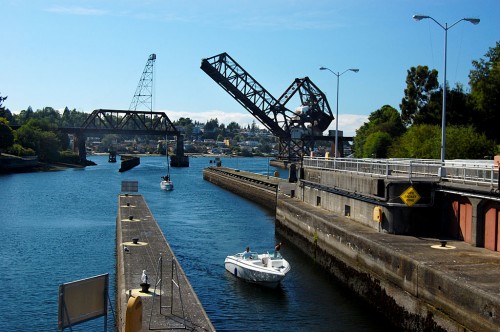 The Hiram M. Crittenden Locks in Seattle can raise a 760 by 80-foot-wide vessel 26 feet from the level of Puget Sound to the level of Salmon Bay in 10 to 15 minutes. There are two parallel locks, one for large vessels and the other for smaller craft.
The Hiram M. Crittenden Locks in Seattle can raise a 760 by 80-foot-wide vessel 26 feet from the level of Puget Sound to the level of Salmon Bay in 10 to 15 minutes. There are two parallel locks, one for large vessels and the other for smaller craft.
We showed the adjacent Carl S. English Jr. Botanical Garden yesterday.
Pedestrians can cross locks
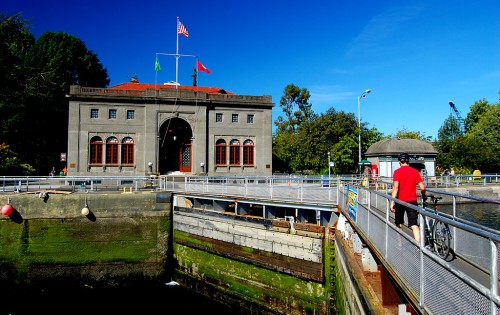 There is considerable pedestrian traffic crossing the locks. Cyclists have to walk their bikes, but I counted a dozen or more using the gardens and park as a shortcut.
There is considerable pedestrian traffic crossing the locks. Cyclists have to walk their bikes, but I counted a dozen or more using the gardens and park as a shortcut.
Locks form permeable barrier
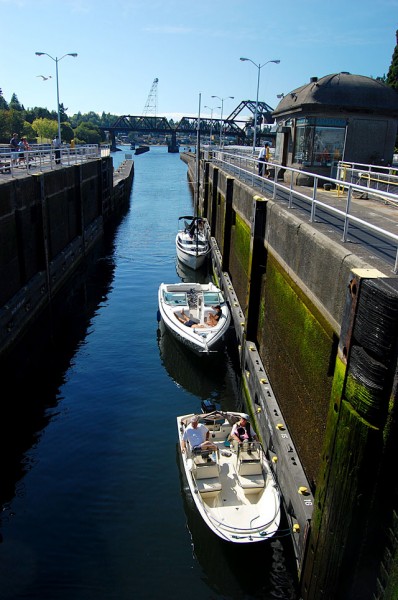 The locks form a permeable barrier between Lake Washington’s freshwater ecosystem and the potentially damaging saltwater of Puget Sound. They are designed to allow the passage of vessels while minimizing saltwater intrusion, something we Florida folks understand too well.
The locks form a permeable barrier between Lake Washington’s freshwater ecosystem and the potentially damaging saltwater of Puget Sound. They are designed to allow the passage of vessels while minimizing saltwater intrusion, something we Florida folks understand too well.
Second Renaissance Revival Style
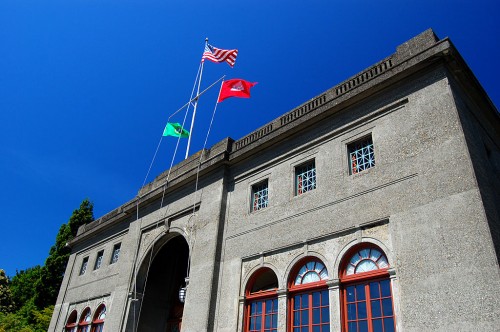 When engineer Hiram M. Crittenden arrived in Seattle in 1906, he saw a shallow canal used for floating logs from Lake Washington to Puget Sound. His notebooks show that he envisioned a set of locks big enough to accommodate The Lusitania, the largest ship of her day.
When engineer Hiram M. Crittenden arrived in Seattle in 1906, he saw a shallow canal used for floating logs from Lake Washington to Puget Sound. His notebooks show that he envisioned a set of locks big enough to accommodate The Lusitania, the largest ship of her day.
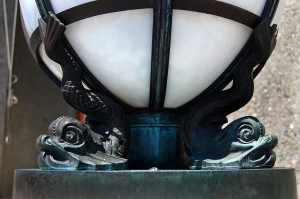 What had begun a shallow log flume became an 8-mile-long canal, 100 feet wide and 30 feet deep, a park brochure says.
What had begun a shallow log flume became an 8-mile-long canal, 100 feet wide and 30 feet deep, a park brochure says.
The construction of the locks began in 1911. Crittenden retired in ill health before his project was officially dedicated on July 4, 1917.
The administration building was designed in the Second Renaissance Revival Style in 1914. It is on the National Register of Historic Places.
Fish ladder constructed in 1916
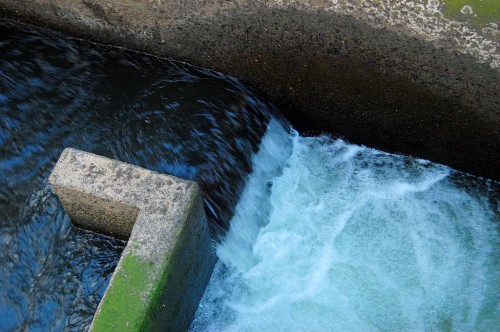 As salmon move upstream from saltwater to the fresh water to spawn, they have to pass the locks and dam. In 1916, the Corps of Engineers constructed a fish ladder consisting of 10 steps.
As salmon move upstream from saltwater to the fresh water to spawn, they have to pass the locks and dam. In 1916, the Corps of Engineers constructed a fish ladder consisting of 10 steps.
I’ve seen and been through enough locks that they didn’t interest me that much. The fish ladder, though, plowed new ground.
Ladder replaced in 1976
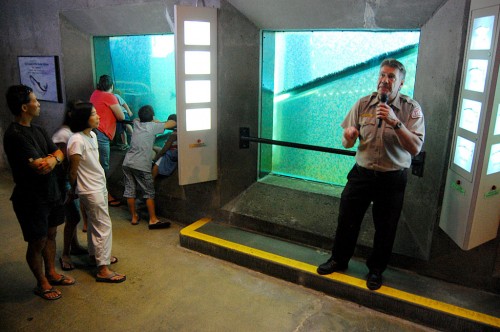 The original fish ladder was replaced with a 21-step ladder and underwater viewing gallery in 1976. Program director Jay Wells had his audience’s rapt attention until someone noticed some Sockeye salmon heading up the ladder behind him.
The original fish ladder was replaced with a 21-step ladder and underwater viewing gallery in 1976. Program director Jay Wells had his audience’s rapt attention until someone noticed some Sockeye salmon heading up the ladder behind him.
Those babies are HUGE
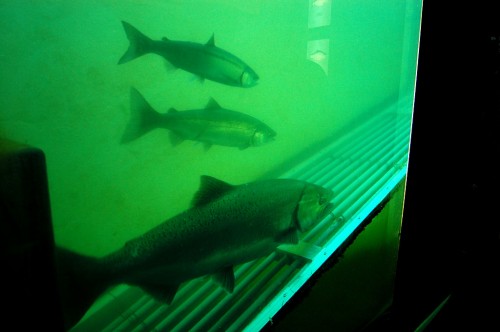 The Sockeye was impressive enough to this 3-Mile Creek fisherman, but then a King came into the chamber.
The Sockeye was impressive enough to this 3-Mile Creek fisherman, but then a King came into the chamber.
That’s the kind of fish they were tossing around in the photos of the Pike Place Fish Market. We’re talking about something the size of a respectable log with fins.
Some of the fish were netted and tagged as they passed through the facility.
Crittenden Locks Photo Gallery
Click on any photo to make it larger, then click on the left or right side to move through the gallery.













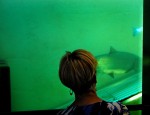









Salmon are remarkable fish. The industry is enormous, too, beginning with their natural predators like bears, sea gulls and men with hand nets. I would estimate that most the male population of Alaska hits the rivers and streams to go salmon dipping each year. My aunt’s baked salmon is a good memory from my years in Fairbanks. My uncle used to smoke it and can it.
It’s fascinating to watch the bears catch the salmon!
Are you home yet?
It depends on how you define “yet” and when you read this. Today is Monday, Aug. 8. As of now, yes, I’m in Florida.
If you read this Tuesday afternoon, I hope to be on the way back to Cape to pick up all my stuff left behind when I had to fly back after my transmission problems. I’ll be in town for about a week, then it’s back home to FL. I’ll be back in Cape in October for Mother’s Birthday Season.
My kid was asking me last night how many more days I’ll have to be in Cape before I’m considered a resident and have to pay state income tax? (Boy, would MO ever be disappointed in MY income. Y’all would probably have to give me a refund.)
Nice. I was able to see some locks up close at TVA’s Lake Gunterville in Northern Alabama near Chattanooga. The large gears and other mechanism that moved the gates were fascinating.
Your article about Salmom reminds me of the trip to Alaska, Paul and I took with the Special Military Retired Travelers several years ago. We spent three months touring all through East side of Alberta Canada taking in all the highlights, then on up to Dawson Creek. We followed the Alaskan Highway and the Alaskan pipeline from beginning to end.
After spending a good while in Dawson City taking in all that old historic town where Jack London wrote “Call of the Wild” and visiting Robert Frost cabin, where he wrote his poetry we crossed the Yukon River on a barge in our motor homes. Then we crossed over the top of the world which was quite an exsperience.
We spent about a week at the North Pole before heading back down.Then after trip up Mt McKinley we came back to stay at this small place called Hyder, Alaska home of the bears.It was really something to go out on the dirt road they call a street and see a bear walking toward you. We went down to a bridge where the bears gather to eat their meal of salmon in the evening. They would set on the bank, dip down into the water pull out a fish with one paw and take it other paw and fillet that thing in about a second with its toenails.
However the baby bears set under the bridge and was crunching on fish they had caught, bones and all since they had not learned yet how to fillet their meal.
We were able to get TV communication there and heard on the news about 911 and all entrances back into US were closed, this is another story all together but we did finally get back across the border.
You speaking of Salmon brought up a lot of memories since while that trip we had salmon about every which way it can be cooked. I was very tired of eating it by the time we returned home.
Nice job on the Salmon ladder story. It even brought back memories of the visit there as well but you tell the story better than anyone! Gee you should that this for a living!! 🙂
When I worked at Mt. Rainier in ’69 a bunch of park employees took their annual “headboat” trip out into the ocean for salmon. This “Whitewater River” MO. flyfisherman caught the biggest, a 25 pounder. A maintenance foreman there knew what to do. He cut it in half and grilled each at a certain height over a bed of charcoal, basting with a concoction all the while for fully two hours. I can still see those savory red slabs on the serving table, feasting about 30 people!